Related Research Articles
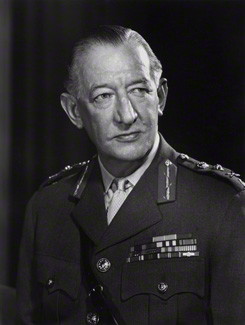
Field Marshal Sir Archibald James Halkett Cassels, was a senior British Army officer who served as Chief of the General Staff (CGS), the professional head of the British Army, from 1965 to 1968. As a young man he was a first-class cricket player, initially playing in India for the Europeans against the Hindus in the Lahore Tournament and going on to play for a Punjab Governor's XI against Northern India team and for a Viceroy's XI against the Roshanara Club. He later played for the British Army cricket team against the RAF at The Oval and then played for the Egyptian national side against HM Martineau's XI in Alexandria.

Lieutenant-General Sir Thomas Jacomb Hutton, was a British Army officer who held a variety of vital staff appointments between the First and Second World Wars, ultimately commanding the Burma Army during the early stages of the Japanese conquest of Burma in early 1942.

Lieutenant General Sir Henry Royds Pownall, was a senior British Army officer who held several command and staff positions during the Second World War. In particular, he was chief of staff to the British Expeditionary Force (BEF) in France and Belgium until the battle of France in May/June 1940. He was later chief of staff to General Sir Archibald Wavell until the fall of Singapore in February 1942, and was then chief of staff to Admiral Lord Louis Mountbatten in South East Asia in 1943–1944.
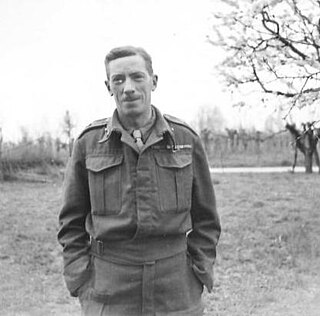
Major General Robert Keith Arbuthnott, 15th Viscount of Arbuthnott, was a senior British Army officer who served in both the First World War and the Second World War.

Lieutenant-General Guy Granville Simonds, was a senior Canadian Army officer who served with distinction during World War II. Acknowledged by many military historians and senior commanders, among them Sir Max Hastings and Field Marshal Sir Bernard Montgomery, as one of the best Canadian generals of the war, Simonds, after serving the first few years of the Second World War mainly as a staff officer, commanded the 1st Canadian Infantry Division with distinction in Sicily and Italy from July 1943 until January 1944, and later II Canadian Corps during the Battle of Normandy from June−August 1944 and throughout the subsequent campaign in Western Europe from 1944, towards the end of which he temporarily commanded the First Canadian Army during the Battle of the Scheldt, until victory in Europe Day in May 1945. The historian J. L. Granatstein states the following about Simonds: "No Canadian commander rose higher and faster in the Second World War, and none did as well in action. Simonds owed his success wholly to his own abilities and efforts—and those of the men who served under him."
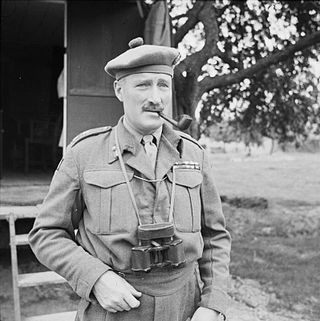
General Sir Neil Methuen Ritchie, was a British Army officer who served in the First and Second World Wars. During the Second World War he commanded the British Eighth Army in the North African campaign from November 1941 until he was dismissed in June 1942 after a disastrous defeat in the Battle of Gazala.

General Geoffrey Kemp Bourne, Baron Bourne, was a British Army officer.
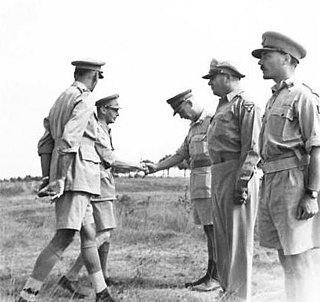
General Sir Charles Falkland Loewen, was a Canadian-born British Army officer who served as Adjutant-General to the Forces from 1956 to 1959.

Lieutenant General Sir Charles Walter Allfrey, was a senior British Army officer who served in both the world wars, most notably during the Second World War as General Officer Commanding of V Corps in North Africa and Italy from 1942 to 1944.

Lieutenant-General Sir Edmond Charles Acton Schreiber, was a senior British Army officer who served in both the First World War and the Second World War. In the latter he commanded the 45th Infantry Division, V Corps and the British First Army.

Southern Command was a Command of the British Army.

Western Command was a command of the British Army.

General Sir George Watkin Eben James Erskine, was a British Army officer from Hascombe, Surrey. After he graduated from Royal Military College, Sandhurst, Erskine was commissioned into the King's Royal Rifle Corps and saw action on the Western Front of the First World War. During the Second World War, he commanded the 7th Armoured Division from 1943 to 1944. Erksine later commanded counterinsurgency operations against the Kenya Land and Freedom Army (KLFA) during the Mau Mau rebellion.
Major General Sir Edmund Hakewill-Smith, was a senior British Army officer who served in both the First and Second World Wars.
Lieutenant General Sir Roderick William McLeod, was a British Army officer who achieved high office in the 1950s.

Aldershot Command was a Home Command of the British Army.
General Sir Gwilym Ivor Thomas, was a senior British Army officer who saw active service in both World Wars. He is most notable for commanding the 43rd (Wessex) Infantry Division throughout the campaign in Western Europe from June 1944 until Victory in Europe Day in May 1945, and later rose to become Quartermaster-General to the Forces.
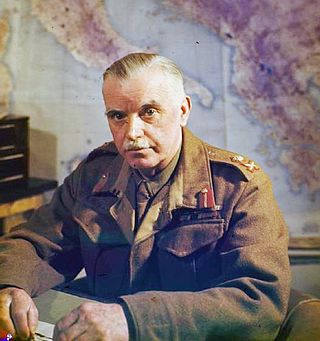
General Sir William Duthie Morgan, was a British Army officer. During the Second World War, he commanded the Mediterranean Theatre of Operations during the late stage of the war.
Lieutenant General Sir Brian Charles Hannam Kimmins, was a British military commander who served as the General Officer Commanding Northern Ireland District.
General Sir John Edward Spencer Brind, was a British Army officer who commanded the 4th Division.
References
- 1 2 3 4 "Major-General Sir Brian Wyldbore-Smith". The Telegraph. 13 December 2005. Retrieved 12 June 2020.
- ↑ "No. 33974". The London Gazette . 1 September 1933. p. 5732.
- ↑ Maj-Gen H. Essame, The 43rd Wessex Division at War 1944–45, London: William Clowes, 1952, pp. 217–8; Appendix B.
- ↑ "Army Commands" (PDF). Retrieved 7 June 2020.
- ↑ "Major General Sir Brian Wyldbore Smith". The Times. 6 December 2005. Retrieved 12 June 2020.